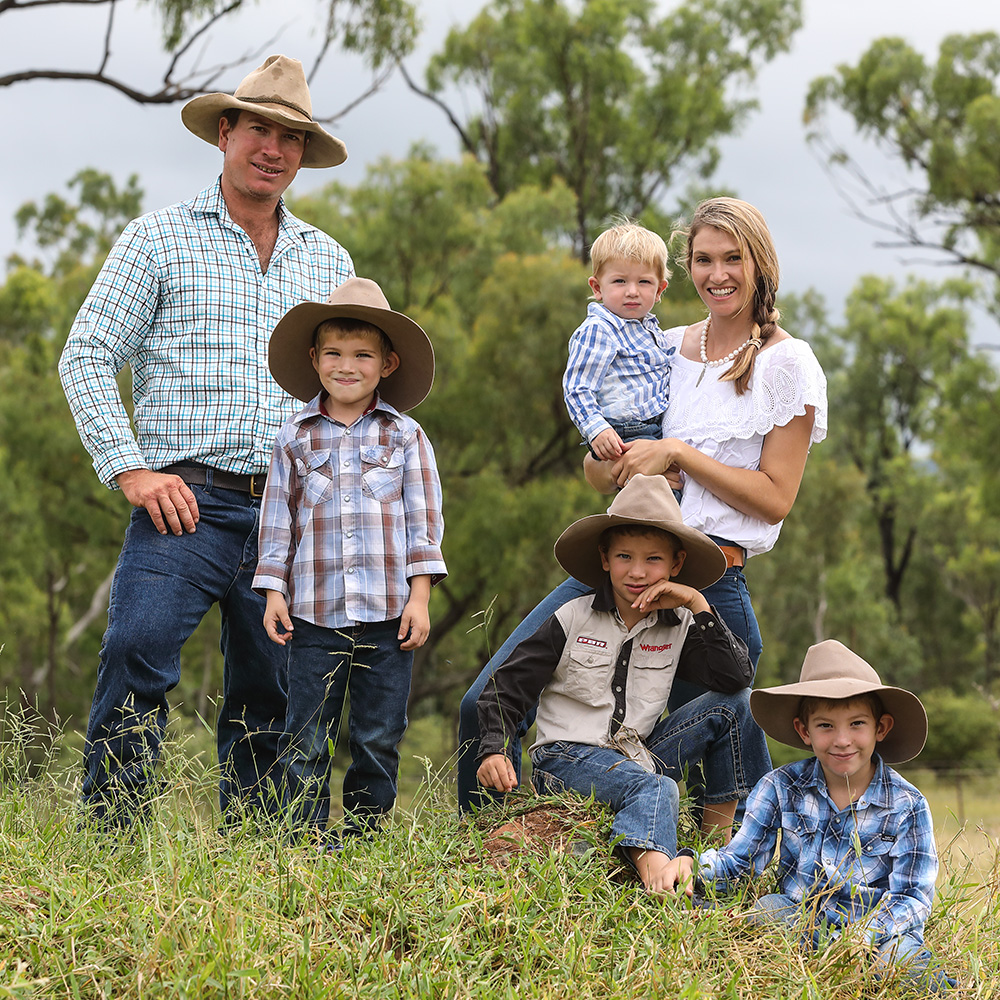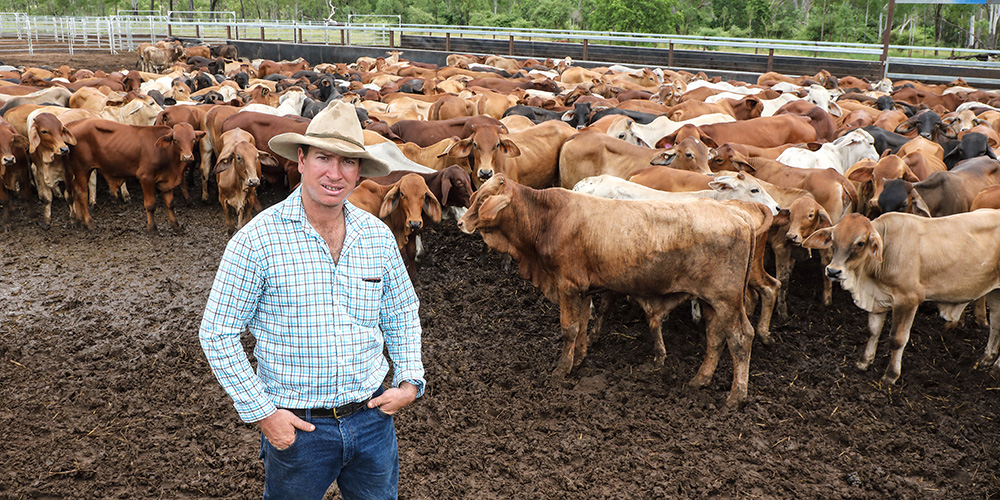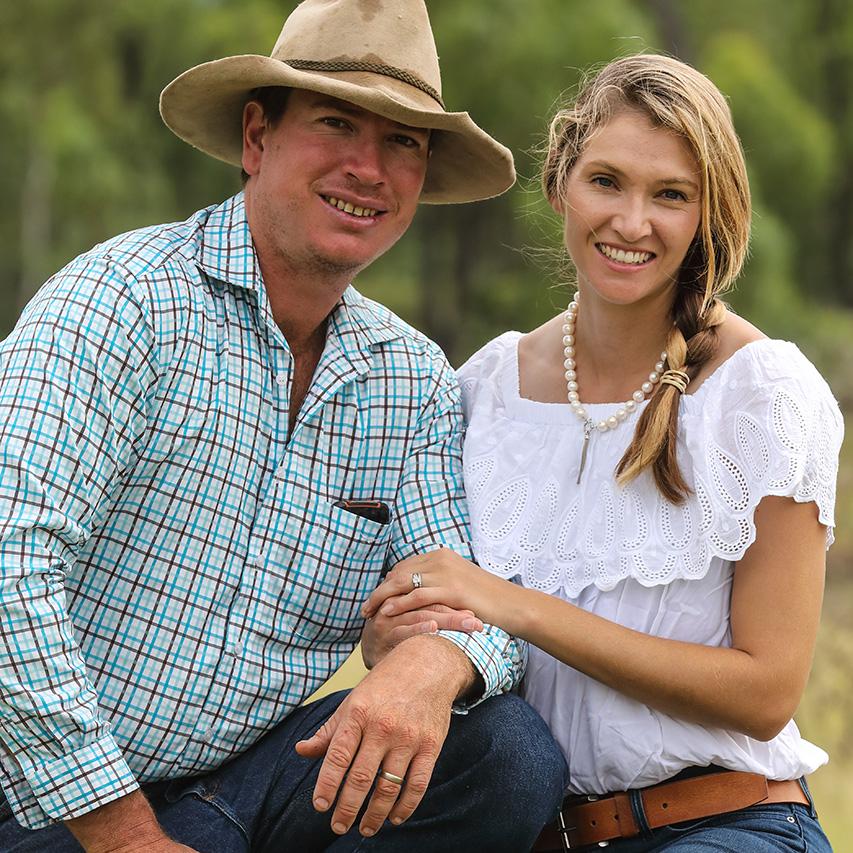PRODUCER CASE STUDY
Kale & Karin Robinson
Hillsborough Station, Ravenswood
Farmers know climate, interest rates and cattle prices cannot be changed, but the response to these forces can drive long-lasting and balanced practices to benefit both beef production and sustainability.
Introduction
That’s the sentiment which has propelled North Queensland beef producers Karin and Kale Robinson to undertake significant changes to their land and livestock management at Hillsborough Station.
Located in the Burdekin region, approximately 70 kilometres from the coast at Ayr in the Great Barrier Reef catchment, the 43,000 hectare (106,000 acre) property runs close to 6000 head of Brahman and Droughtmaster-cross cattle.
Kale and Karin’s new approach to managing the property and its natural resources has been inspired and supported by their involvement with Project Pioneer and their work with Resource Consulting Services (RCS).
The Robinsons purchased Hillsborough Station three years ago in partnership with Karin’s parents, Pat and Jenny Williams, who are based in nearby Charters Towers, and in just two years participating in Project Pioneer, the Robinsons have already increased their carrying capacity through improved pasture management.
But at the crux of this improvement is not just a change in on-farm practices, but in the mindset which underlies their management decisions.
“When we first moved here, we came into what was classed as drought in this area. Since we’ve had the information and knowledge provided by Project Pioneer, we approach the land with different eyes,” Karin said.
Kale said the tools and support they now have access to had proved invaluable in producing a range of data to help inform management decisions and give them the confidence to act.
“The data is useful for me and Karin because we can see what is really happening rather than just blaming things on drought, which is what we would have done two years ago before starting Project Pioneer,” Kale said.
“By collecting data and analyzing it, we know our benchmark carrying capacity is 8.5 stock days per hectare per 100mm of rain. We have been able to develop a management plan to match the stocking rate to Hillsborough’s carrying capacity.”
“In agriculture, you can’t change a lot of things, but there are things you can have some control over. That’s the frame of mind the project puts you in, so you’re not just living on hope that tomorrow it might rain,” Karin said.
“You start to understand what the land is doing and how it responds to change, and it’s exciting.
“Since being involved in Project Pioneer we’ve had a paradigm shift – we see ourselves now as being grass producers, because if we can nail that, then the beef is going to be a by-product and it’s going to be better for our business.
“Obviously there is big component of understanding the cattle side of production as well, but I think if you go back to basics, and understand that’s it’s also about what’s happening in the soil it gives you new tools. The information is there, so use it.”
Positive change
With sugarcane fields close to one side of the property and the Leichhardt Range running along another boundary, Hillsborough Station comprises a diverse range of soils and land types. It is also home to a number of waterways, including Eight Mile Creek and Banana Creek and part of Barratta Creek, which all flow into the Reef catchment.
Amongst the biggest changes the Robinsons have implemented through Project Pioneer to manage this biodiversity is the introduction of a rotational grazing system and the adoption of new on-farm technology.
The combination of the new initiatives will help maintain and increase pastures, and prevent sediment run-off and soil loss, ultimately boosting productivity and profitability.
“We have already noticed that just by changing little practices that we have so far, and increasing our body of pasture, there has been positive effects. It’s also profitable to our business as well – it’s a win-win.
“By understanding the grazing circles of the cattle and managing pastures, we’ve been able to increase our carrying capacity.
“We’re about to start a cell rotational grazing system that incorporates a walk-over-weighing system.
“When the cattle walk through to get to water, it will record their weight and instead of us having to muster a whole paddock, if we want to sell a certain amount of cattle, we can just draft them off in paddocks and pick them up. It will also help us identify any non-performers or sickness.
“We’ve also just built new cattle yards with a low-stress focus. The design takes into consideration the behavior of the cattle and how they run, and it decreases the labour needed in the yards, while increasing safety.
“We also have a crush-side system that enables more data to be stored. It records weight and reads the NLIS for each different beast. If a female is in-calf, it can also record three different types of data for that beast – for example if it is 1-3 months pregnant, 3-6 months pregnant or over 6 months.”
Karin said Project Pioneer is providing the ongoing support and guidance needed as they implement change.
“The great thing about Project Pioneer is you don’t just go to little things every now and then. You have support all the time, including on-property visits from people who are just so knowledgeable,” Karin said.
“We have a grazing chart and on-farm monitoring sites throughout the property that help us really look at the biodiversity, estimate the number of stock days per hectare that might be there, and basically help us evaluate for the whole paddock.
“Being able to read the country and see how many stock days you’ve taken out and thinking ‘maybe we could have put a bit more in there’, it’s a continual process, but also when you’re new at it, you have that support from Project Pioneer and RCS.
“The on-farm monitoring sites are a good record of our management. It’s a chance to see the impact of management changes that we’re making such as more biodiversity in the different grass species coming through.
“Besides drought, we’ve had some abnormal seasons as well. Last year, we had winter rain, and so we’re managing those events as well. It has allowed us to have maneuverability in our business and allows you to make real-time decisions.”
More tools for the business kit
Taking a more analytical approach to decision making in the environment of a family business has been another benefit of Project Pioneer for the Robinsons.
“We found it has given us more confidence in trying to make some hard decisions or communicate what might need to be done, and removes the emotion. It gives us some more facts and data to do that, especially when you’re communicating within a family business,” Karin said.
“You’re not just saying ‘I think we should do this’. It takes the emotion out of decision-making, and I think that’s one of the biggest impacts it’s had on our business.
“Project Pioneer is not just about business. It touches on succession and communication and setting yourself up for the future. It touches on everything.”
Karin said while changing their management practices sounds like an overwhelming task, RCS had made the process accessible to the average producer.
“We’re lucky in the sense that we have good communication with my parents. We have regular business meetings just touching base, to make sure we’re all on the same page.”
Empowered with knowledge
The Robinsons said investing the time and energy into learning more about pasture management through Project Pioneer was empowering.
“Investing in education is an investment in yourself, because it opens up your mind to new ways of doing things and understanding how the land works.
“I know the challenges, the stigma it has. We’re the first to put our hands up and say we questioned why we should get involved, before we made the decision.
“But the reality is we’re seeing positive changes happening, and it’s benefiting our business.
“Project Pioneer puts you in contact with like-minded people and people looking for ways to keep moving forward and not just surviving. That’s refreshing, because we all know the obstacles that living on the land comes with.
“You can’t change the weather, interest rates or cattle prices, so what can you change? Project Pioneer has helped us answer that.”
GET IN TOUCH
Want to talk more about Project Pioneer, or how RCS can help you deliver industry-leading results?




Project Pioneer is funded by the partnership between the Australian Government’s Reef Trust and the Great Barrier Reef Foundation. The project is delivered by RCS with support from WWF, Maia Technology, Farm Map 4D and CQUniversity.




